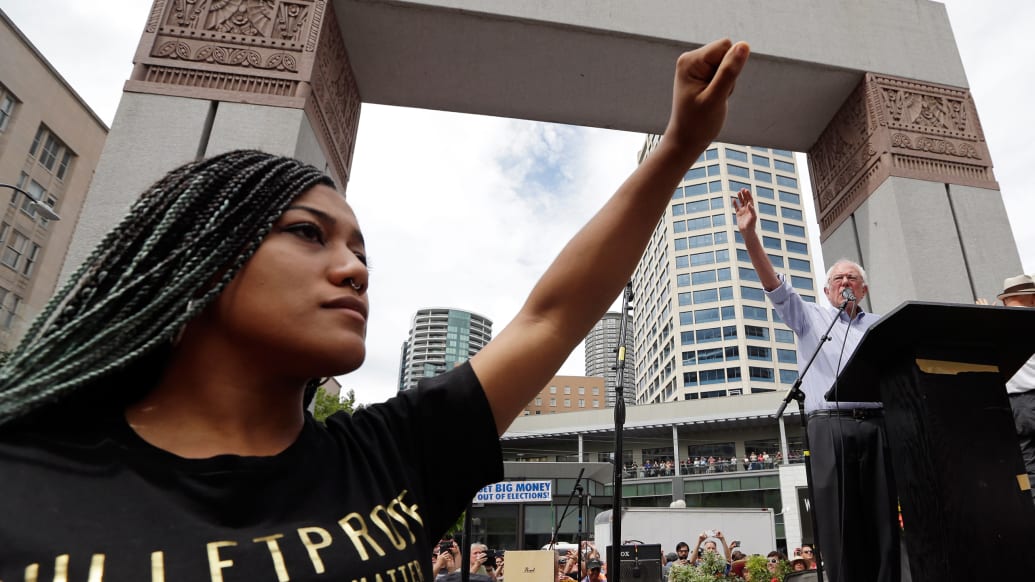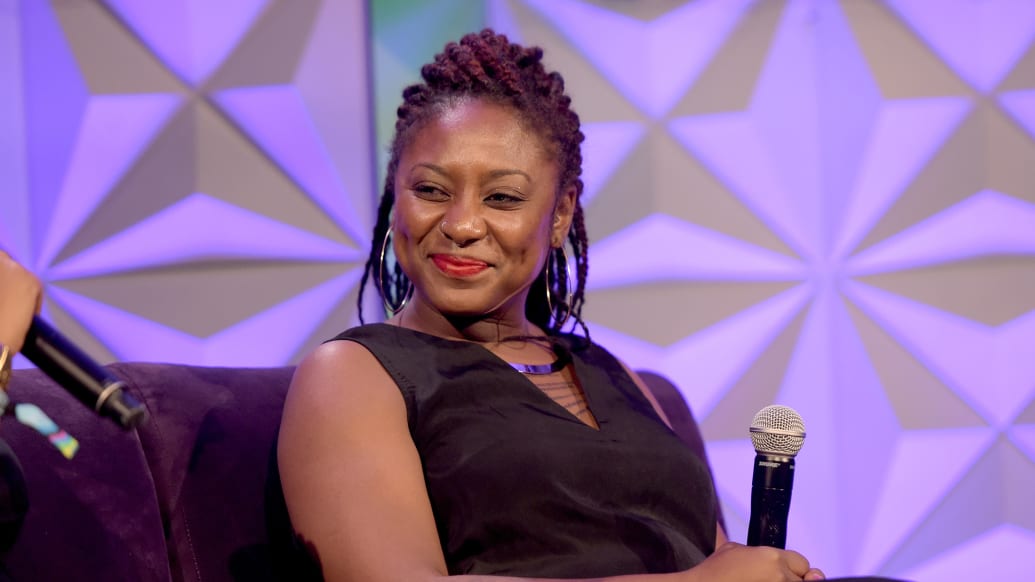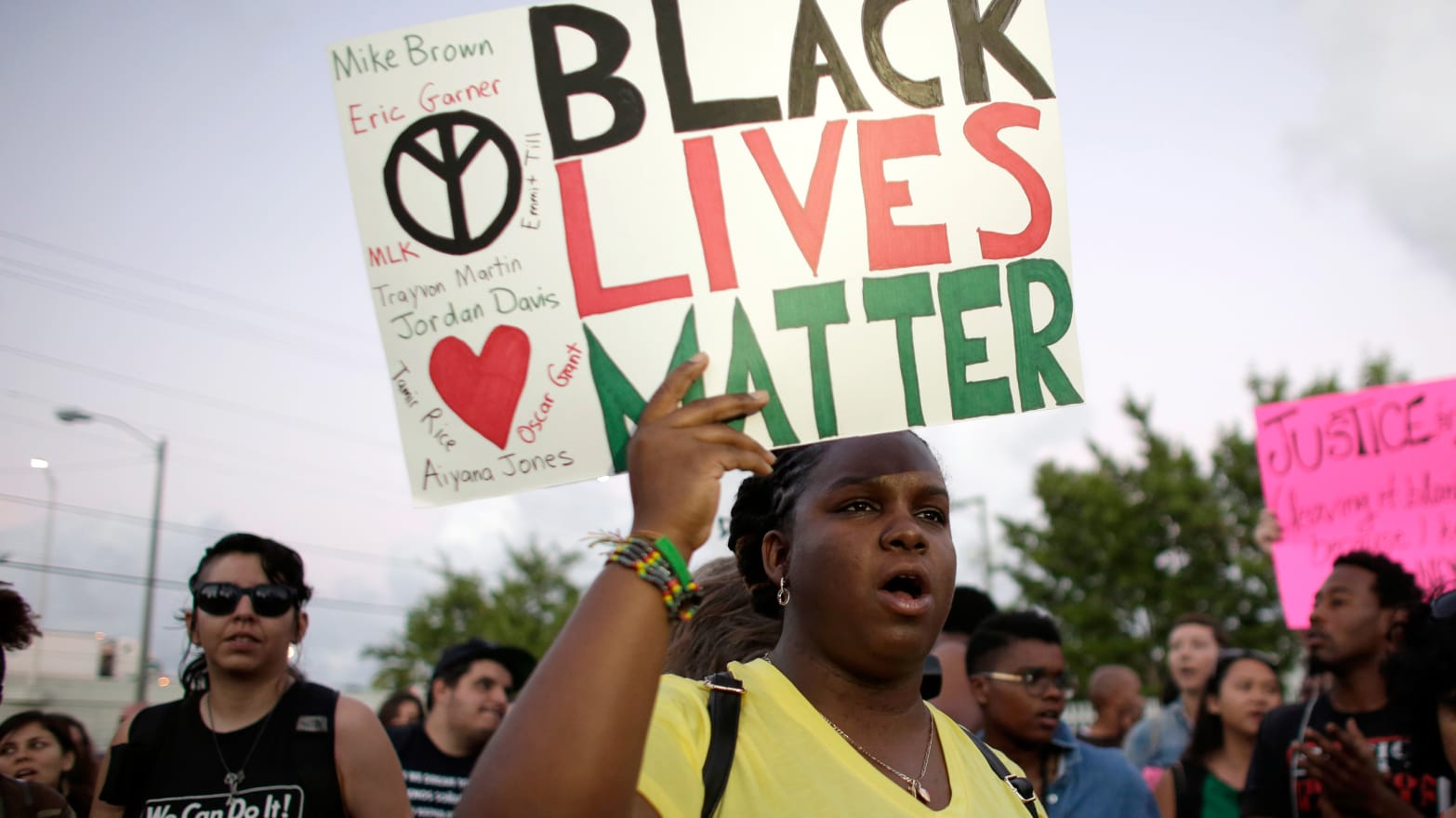Last Saturday, for the second time in a month, protesters who identified themselves as members of the Black Lives Matter movement leapt onstage to interrupt a speech by Democratic presidential candidate Bernie Sanders.
“I was going to tell Bernie how racist this city is, even with all of these progressives, but you’ve already done that for me,” said Marissa Johnson, who was roundly booed before demanding and receiving a four-minute moment of silence for the death of Michael Brown, as Sanders stood behind her and fellow protester Mara Willaford.
The Seattle protest sparked a particularly strong counter-reaction, especially among the white liberals who form the core of Bernie Sanders’s base. Sanders is not the front-runner to win his party’s nomination. Many on both the left and right are asking: Why him?
Sanders currently trails Democratic front-runner Hillary Clinton, whose events have not yet been successfully interrupted, by 38 points in Quinnipiac’s most recent national poll. He has made criminal justice reform a tentpole issue early in his campaign. Jeb Bush, who trails Republican front-runner Donald Trump by 10 points, allegedly reached out to local Black Lives Matter leaders a night before, then was shouted down at a campaign event less than 24 hours later.
Why protest Bernie and not Hillary? Why Jeb and not Trump?
Interviews with 10 members of both local and national branches of Black Lives Matter—as well as with the political campaigns they’ve tested—reveals no single, easy answer. It’s one part logistical—from the less stringent security of a second-tier candidate to the simple timing of a speech.
And it is another part—a larger part—purely organizational.
In response to the death of unarmed black teen Trayvon Martin and the acquittal of his killer, activists Patrisse Cullors, Alicia Garza, and Opal Tometi rallied together on Twitter to create visibility with a unified phrase: Black Lives Matter. As more black Americans —like Tamir Rice, Michael Brown, Eric Garner and Freddie Gray—were killed by police, the phrase gained prominence and resonance—both on Twitter, and in the protests that would follow, nationwide.
In the process of trying to grow its message from a hashtag spawned by three activists into a national political movement, Black Lives Matter—a decentralized organization with official and unofficial Facebook pages, meet-ups, and blogs throughout America and the world—is splintering internally on how to express that message, and even defining what that message truly is.
After all, when an article says Black Lives Matter interrupted a campaign event, who is a part of Black Lives Matter, anyway? The answer to that question is even harder to answer.
The answer to that question might be a small group of people who self-identify as a “radical organization.” The answer to that question might also be anyone.
And the answer to that question might define the future of the American left, which has split over race, party politics, and the limits and powers of protesting since two activists took over a podium in Seattle seven days ago.
***
Nikki Stephens, 16, was hit with a barrage of Facebook messages and texts on Saturday night.
“My phone was blowing up,” Stephens says. “Everyone automatically assumed I was one of the two women”—the protesters who took over the Sanders event in Seattle.
Stephens, a high schooler and track athlete, had the keys to the “Black Lives Matter: Seattle” Facebook page. She had “watched the video from all angles” of Johnson and Willaford, and now—as the de facto voice of Black Lives Matter: Seattle, she believed—it was her turn to speak.
She had been drawn into the movement months ago by an activist who came to her school and compelled her to take action on the recent spate of young black men killed by police.
“I wanted to raise awareness—that this is not a joke. That people are actually dying,” she says. “That’s why I made the page.”
With the help and guidance of her friend, she started sharing stories of injustice and dispatches from the national chapter. Quickly, her page grew to be the largest Black Lives Matter page in Seattle.

Then Johnson and Willaford, whom Stephens had never met, took over the podium at the Bernie Sanders’s campaign event last weekend.
“I felt like I had to come up with a response,” she says.
There was, however, a problem: Stephens is a Bernie Sanders supporter. Panicked, she called her friend who had gotten her into the movement to plan her next move.
“I was like, ‘What should I do? I don’t really know what to do,’” she says.
As the night progressed, she started receiving messages filled with hate, threats, and racial slurs—especially, she says, from Bernie Sanders fans. They all wanted an apology—one for something she didn’t do.
So she crafted one.
“To the people of Seattle and #BernieSanders I am so sorry for what happened today in Seattle. I am a volunteer who just runs this page and I am only just starting to get into the movement,” she wrote. “I was unaware of what happened and now that I’ve seen the video [of the event] I would like to say again that I am sorry. That is not what Black Lives Matter stands for and that is not what we’re about. Do not let your faith in the movement be shaken by voices of two people. Please do not question our legitimacy as a movement. Again I would like to apologize to the people of Seattle and I will be trying to reach out to Mr. Sanders.”
Some in the national media ran with it. ‘Black Lives Matter’ had apologized.
That’s when Stephens received messages from both Marissa Johnson and Mara Willaford.
“Of course, you can’t tell tone by text. But when they approached me, through texting, it felt sort of aggressive,” says Stephens. “But it wasn’t like they were mad. They were like, ‘Who are you? Why’d you start your page?’”
They told Stephens to change the name of her page—that she had no claim to Black Lives Matter: Seattle.
However, Willaford, 25, and Johnson, 23, had not been public leaders of any Black Lives Matter: Seattle pages up until the day of the event.
At 5:45 a.m. on Saturday, Johnson and Willaford created a separate Facebook page, also, confusingly enough, called “Black Lives Matter Seattle.” At 6:35 p.m., they issued a press release—the page’s first post—called “Black Lives Matter #BowDownBernie Action” that listed Johnson as a press contact and was signed by both Johnson and Willaford.
At the bottom of the note, they are listed as “Black Lives Matter Seattle co-founders.”
Johnson and Willaford were previously leaders of the group Outside Agitators 206, an activist coalition based in Seattle. According to OA206’s website, the fourth of the organization’s four points of unity is this:

“Fuck the police: As an institution fundamentally rooted in white supremacy and anti-Blackness we reject the police presence in our communities, absolutely. It is our responsibility to hold each other accountable and keep each other safe.”
The organization appeared largely dormant over the last several months. According to its website, the group’s sole activity in July was the reposting of a Movement for Black Lives event invitation and an article from TheRoot.com.
After the event, Stephens—thinking she had accidentally claimed a page that wasn’t her own and facing mounting pressure—ceded the name of the page. She changed the name to “Black in Seattle.” Willaford and Johnson’s page was now the primary Black Lives Matter Seattle group on Facebook.
“They said, ‘We appreciate what you’re doing. We appreciate you trying to be involved,’” she says of the texts. “‘But it’s not an official message. We’ve gotten calls from the national people at Black Lives Matter.’”
Then, later on, another Facebook group claiming to be a part of Black Lives Matter instead demanded Bernie Sanders and his Seattle-based organizers apologize to the movement. Some national media reported that as a Black Lives Matter response, as well.
The national Black Lives Matter Facebook page then posted a statement at 2:15 a.m. Sunday.
“The #BlackLivesMatter organization did not create any petitions demanding apology from Seattle based organizers. We have not issued a public apology, neither have we made any public statements demanding an apology.”
So who is Black Lives Matter in this situation? Did the movement send protesters to disrupt Bernie Sanders?
“I didn’t. My chapter did,” says Patrisse Cullors—one of three people credited with starting and spreading the #BlackLivesMatter hashtag that was used to help grow a national movement. She’s also the founder of Dignity and Power Now, a Los Angeles-based organization that works for the rights of incarcerated people and their families. “What we do is we support the chapters. We support their local demands and goals. They tell us what they need us to build support around.”
Cullors, 32, says she met up with Willaford at a Black Lives Matter national retreat and that they “talk all of the time,” but she never gave direct instructions to interrupt Sanders’s rally. She calls Willaford and Johnson’s branch “a very new chapter.”
“That chapter did all the work. And we supported it by ensuring they were a part of the chapter,” says Cullors. “It’s very rare there’s a national directive for people to do things. We amplify and support.”
But what about the leader of the larger Black Lives Matter Facebook group in Seattle—one that existed publicly well before Johnson and Willaford got in front of a podium in Seattle?
“I’m not sure where she was coming from,” says Cullors. “I think what’s important is that folks understand the point of disruption: to challenge business as usual, to really challenge the community of Seattle—largely white liberals—and challenging their inability to see anti-black racism, as a part of a larger pushback against the state.”
Does she understand why there might be confusion over who has true ownership of the message in Seattle? If Stephens had publicly acted first and not Willaford and Johnson, would she not be in charge?
“I don’t know how to answer that question,” says Cullors. “There is a network called Black Lives Matter, with chapters and local affiliates. It could be very confusing for some to think it’s all the same. There could be some that use our name, but it doesn’t necessarily mean it’s in alignment with our message.”
Cullors says there are now “registered chapters” of the national Black Lives Matter movement, and cites Boston, Los Angeles, the Bay Area, and now Seattle as those who have filled out the necessary paperwork.
But a list of official chapters does not appear on the official Black Lives Matter website and is not publicly available, according to Cullors. There is no registration form on the official website and no statement noting that local Black Lives Matters groups must sign up with the national branch.
Willaford and Johnson did not respond to repeated requests for comment by phone, email, and social media channels. And Cullors wanted to note that she has no problem with Stephens, herself—in fact, she’d like her to meet with Johnson and Willaford to see how she can help the movement—but she believed the apology to be off-message.
“I don’t think it’s necessary to issue an apology trying to censor black folks,” she says.
“Anyone can be a Black Lives Matter activist,” she adds. “That [statement] wasn’t official.”
***
The Seattle disruption exacerbated a nascent divide on the activist left between black and white progressives.
Some white writers, like Gawker’s Hamilton Nolan, wrote after the event that the Black Lives Matter movement was alienating the candidate that best served the movement’s interests—or, as he titled his post, “Don’t Piss On Your Best Friend.”
“Many on the left find it hard to come out and say ‘this was stupid,’ because they support both Bernie Sanders and the Black Lives Matter movement,” he wrote. “That is a misperception of the political landscape. Believing that a small group of angry young protesters did something that was not well thought out need not make you feel guilty or racist; rash and counterproductive things are what young people do.”
After criticism about the story surfaced—including a piece in Death+Taxes titled “Bernie Sanders Fans: White Paternalism Ain’t Just for Conservatives”—New York magazine’s Jonathan Chait took up Nolan’s cause.
“But maybe there is a more important question here than mere tactics,” he wrote. “Perhaps shutting down a political speech is, normatively, wrong.”
In The New Republic, Jamil Smith took issue with some of the responses by white progressive media after the speech.
“Since when are protest tactics designed to make the people whom they are targeting feel more comfortable and less annoyed?” he asked. “And since when is Sanders, or (Republican presidential candidate Ben) Carson, or any candidate exempt from being pushed?”
His story’s title signified a rallying cry for what some protesters believe to be a growing fissure at the left end of American politics: “Black Lives Matters Protesters Are Not The Problem.”
“What was most shocking to me about the reactions to the Bernie Sanders shutdown was the amount of rage from progressive white people for two African-American women who were standing up for what they believe in. The reaction was gross,” Julius Jones, founder of the Black Lives Matter chapter in Worcester, Massachusetts, tells The Daily Beast.
“These are supposed to be the white people who want Black Lives Matter to succeed. These people were willing to throw black people under the bus for the white dude they want to win. That’s the same anti-blackness energy that we’re fighting against.”
By late Saturday night, Nikki Stephens, a rising high school junior in Washington state, may have accidentally received the worst and most vocal of that hate—and some of it from fans of the candidate she had already supported.
“I heard from so many people and, although you are liberal and you do support Bernie Sanders—and you do say you support Black Lives Matter—I saw a lot of them come out and say some very nasty things about the movement. There were so many people posting claiming to be liberals, then going back and using slurs, and perpetuating stereotypes. And the sexism I saw from men,” she says, trailing off.
***
Protesters in Massachusetts’ Black Lives Matters chapters say there’s a simple logistical reason Bernie Sanders’s speeches have been interrupted twice—once in Seattle, and once before in Phoenix last month—but Hillary Clinton hasn’t yet been disrupted.
That reason? The Secret Service, which Boston Black Lives Matter activist Daunasia Yancey describes as “50 men in the building who are willing to kill you.”
Neither Bernie Sanders nor Jeb Bush has those protective details. Hillary Clinton most certainly does.
“They’re not to be pressed in any way. The Secret Service are very dangerous people, and their operation is protect their asset at all costs,” said Jones, who was part of a group of activists who spoke to—instead of protesting against—Hillary Clinton last weekend in New Hampshire. “To be confronting an issue such as police brutality—and then to tell that same group of people that they should go charge at the [former] first lady—is a little shortsighted.”
Yancey, 22, views Black Lives Matter as a “radical” group. But she says that rushing the stage with the intention of taking over the microphone at a Hillary Clinton campaign event is not viable.
“We’re a radical organization, with radical politics, and we have radical tactics. There’s no way of softening that. But we are strategic, and we’re interested in remaining safe and alive. Something like storming the stage was not a possibility with the Secret Service [present],” Yancey says.
According to New England-area Black Lives Matter activists like Yancey and Jones, they came to demonstrate at Clinton’s New Hampshire event last weekend—only to be offered a private meeting with the Democratic front-runner herself.
But the Clinton campaign has a slightly different story to tell about the night the former Secretary of State met with local Black Lives Matter reps. The campaign contends that the Black Lives Matter activists arrived late to the event and were unable to enter because the room was at capacity.
“There were another 15 people who also came late and couldn’t get in, so they all were taken to an overflow room. Our team on the ground offered to essentially swap some people out so that they could go into the town hall with Hillary but they declined and asked to meet with her after the event. She met with them for about 15 minutes after the event,” a Clinton spokesperson tells The Daily Beast.
Some activists for criminal justice reform, like Families Against Mandatory Minimums strategic initiatives director Kevin Ring, believe that Clinton is the candidate who deserves the most scrutiny for her previous stances on mass incarceration.
“It’s incumbent on her, more than others, to explain what precisely she got wrong, and what the country got wrong—and what she would do to reverse that,” Ring says.
In 1994, as the House and Senate were considering whether to pass the Violent Crime Control and Law Enforcement Act, Clinton said (PDF), “We need more police, we need more and tougher prison sentences for repeat offenders. The ‘three-strikes-and-you’re-out’ for violent offenders has to be part of the plan. We need more prisons to keep violent offenders for as long as it takes to keep them off the streets.”
As a senator running for the presidency, she opposed making shorter sentences for crack cocaine-related offenses retroactive for previously-convicted inmates, even though many advocates had called the disparity between crack and powder cocaine sentences unjust.
Both Bill and Hillary Clinton have backed away from the tough-on-crime reforms they championed in the mid-’90s. But, advocates say, since Hillary Clinton was involved in creating a climate of mass incarceration that disproportionately targets black Americans, she has a greater responsibility to address why and how her stances about the criminal justice system have changed.
In their private meeting with Hillary Clinton, members of the Black Lives Matter movement challenged her to reflect on “her personal involvement in the war on drugs and the anti-black policies that were enacted by her family and throughout her career,” Yancey says.
“That’s not what we heard. We didn’t hear the reaction that we wanted,” Yancey adds.
What they heard was talk about policy and legislation. Clinton told them that her previous positions on sentencing were due to a “different climate and a different set of problems” in the ’90s.
With the criminal justice reform that was passed in the ’90s, Jones argues, the “undercurrent of it is anti-blackness. What in her heart has changed… that will actually change the tide? And how can she use her change to be an example for the United States?”
“She has acknowledged the failure of some of her work. It’s just the next step: the acknowledgement of what’s behind that,” Yancey adds. “Hillary Clinton’s feelings about anti-blackness in our government are very important. She wasn’t willing to go there with us, but it’s a crucial conversation. If you’re looking for solutions to the problem… [and] there’s a form of white supremacy in your solutions, that’s going to continue.”
The Clinton campaign contends that their candidate has been reaching out to the Black Lives Matter movement and was paying attention to criminal justice reform and social inequality.
“[O]n an ongoing basis our team has also been reaching out and talking to different parts of the BLM movement as well as a wide range of organizations, activists, stakeholders, etc. so that policy proposals are informed by many voices and experiences,” a Clinton spokesperson tells The Daily Beast. “Hillary has been speaking out about Black Lives Matter and criminal justice reform for some time… it was the subject of her first policy speech of the campaign in April… in which she laid out specific policy proposals. In addition to criminal justice reform she has also broadened to talk about the opportunity gap and systemic inequities.”
Tyrone Brown, a Seattle-based activist who says he “speaks with Black Lives Matter, but not for Black Lives Matter,” says Bernie Sanders was disrupted at his event on Saturday in part “because it was on the eve of the one-year anniversary of Michael Brown’s death.”
“Whether it had been Clinton, Perry, or whoever—if anybody had come to Seattle, something would have happened that day,” he says. “Something would’ve had to have happened to highlight it—that tragedy. In this case, it was Bernie Sanders.”
Brown runs an initiative at Seattle University, where he’s an administrator, called Moral Mondays at SU, which organizes events like talks, discussions, and movie nights as part of a “#BlackLivesMatter initiative.”
Brown met Mara Willaford on the way back to Seattle after the Movement for Black Lives event in Cleveland. He says he now recognizes Willaford and Johnson as the leaders of Black Lives Matter Seattle.
“There’s the slight issue with some semantics around timing: How can they take an action before they become an official chapter for the movement? It doesn’t matter,” he says. “If no one had taken advantage of the fact that the front-runner for the Democratic nomination was speaking in Seattle on that day, somebody was going to take some type of action. They just happened to be the ones that did it.”
***
Although she had to hand over the name to her Facebook group, Stephens says she now believes that the protest was ultimately good for the visibility of Bernie Sanders—and that, days after the event, she sees where Willaford and Johnson were coming from.
“Watching social media after it happened, I came to realize what they were doing. A lot of people wrote in saying that it made them want to learn about Bernie Sanders,” she says. “They inadvertently had done their job—even if that wasn’t their aim.”
Stephens hasn’t heard from Johnson or Willaford since she relinquished the name of the page. She said she’d like to continue her activism, but was discouraged by her experience on Saturday night.
“This really brought out the worst in people,” she says.
“We have waited and waited and waited. Two more people dead in Ferguson. We can’t take a back seat anymore. I want people to clear their minds of what happened, to stop making it about the women [who interrupted Sanders’s speech]. What did you do? You went looking for more information.”
Correction 8/15/15 10:12 AM: This piece was updated to better reflect the origins of the Black Lives Matter movement.


